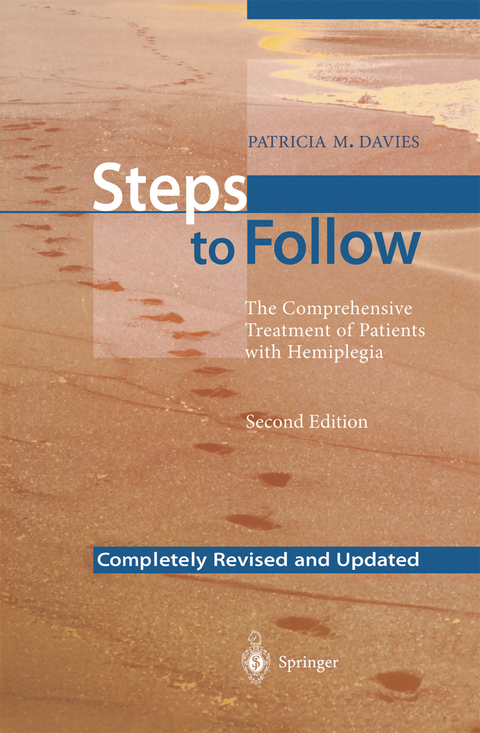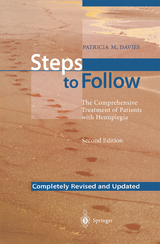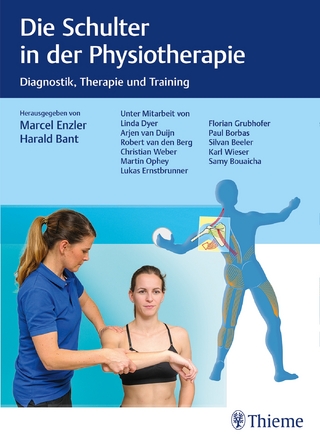Steps to Follow
Springer Berlin (Verlag)
978-3-540-60720-5 (ISBN)
A true paradigm shift is taking place in the field of neurology. Earlier it was regarded as the science of exact diagnosis of incurable illnesses, re signed to the dogma that damage to the central nervous system could not be repaired: "Once development is complete, the sources of growth and regeneration ofaxons and dendrites are irretrievably lost. In the adult brain the nerve paths are fixed and immutable - everything can die, but nothing can be regenerated" (Cajal1928). Even then this could have been countered with what holds today: rehabilitation does not take place in the test tube, being supported only a short time later by an authoritative source, the professor of neurology and neurosurgery in Breslau, Otfried Foerster. He wrote a 100-page article about thera peutic exercises which appeared in the Handbuch der Neurologie (also published by Springer-Verlag). The following sentences from his intro duction illustrate his opinion of the importance of therapeutic exercises and areclose to our views today (Foerster 1936): "There is no doubt that most motor disturbances caused by lesions of the nervous system are more or less completely compensated as a re sult of a tendency inherent to the organism to carry out as expedient ly as possible the tasks of which it is capable under normal circum stances, using all the forces still available to it with the remaining un damaged parts of the nervous system, even following injury to its sub
1 Problems That Cannot Be Seen Directly.- Problems Related to Disturbed Perception.- Some Common Problems Associated with Disturbed Perception.- Reciprocity of Perception and Learning.- Disturbed Perception and Learning.- Implications for Therapy.- Guided Movement Therapy (Guiding).- Therapeutic or Intensive Guiding.- Guiding When Giving Assistance.- Guiding the Patient in a Standing Position.- Considerations.- 2 Normal Movement Sequences and Balance Reactions.- Analysis of Certain Everyday Movements.- Balance, Righting and Equilibrium Reactions.- Task-orientated Arm and Hand Movements.- Considerations.- 3 Abnormal Movement Patterns in Hemiplegia.- Persistence of Primitive Mass Synergies.- The Synergies as They Appear in Association with Hemiplegia.- Abnormal Muscle Tone.- Typical Patterns of Spasticity or Hypertonicity.- Placing.- Reappearance of Tonic Reflex Activity.- Associated Reactions and Associated Movements.- Abnormal Tension in the Nervous System.- Disturbed Sensation.- Considerations.- 4 Practical Assessment - a Continuing Process.- The Aims of Assessment.- Recommendations for Accurate Assessment.- Specific Aspects of Assessment.- Recording the Assessment.- The Comprehensive Evaluation.- Considerations.- 5 The Acute Phase - Positioning and Moving in Bed and in the Chair.- The Arrangement of the Patient's Room.- Positioning the Patient in Bed.- Sitting in a Chair.- Self-assisted Arm Activity with Clasped Hands.- Moving in Bed.- Transferring from Bed to Chair and Back Again.- Incontinence.- Constipation.- Considerations.- 6 Normalising Postural Tone and Teaching the Patient to Move Selectively and Without Excessive Effort.- Important Activities for the Trunk and Lower Limbs in Lying.- Activities in Sitting.- Placing the Hemiplegic Leg and Facilitating Crossing It Over the Other Leg.- Coming From Sitting to Standing.- Activities in Standing with Weight on the Hemiplegic Leg.- Pelvic Tilting with Selective Flexion/Extension of the Lumbar Spine.- Activities inStanding with Weight on the Sound Leg.- Considerations.- 7 Retraining Balance Reactions in Sitting and Standing.- Activities in Sitting.- Activities in Standing with the Weight on Both Legs.- Activities in Standing with the Weight on the Hemiplegic Leg.- Activities During Which the Weight Is on Alternate Legs.- Activities in Standing with the Weight on the Sound Leg.- Considerations.- 8 Encouraging the Return of Activity in the Arm and Hand and Minimising Associated Reactions.- Activities in Supine Lying.- Activities in Sitting.- Activities in Standing.- Stimulation of Active and Functional Movements.- Retraining Selective Flexion of the Arm and Hand.- Considerations.- 9 Re-educating Functional Walking.- Considerations for Treatment.- When to Start Walking.- The Facilitation of Walking.- Practical Ways to Facilitate Walking.- Self-inhibition of Associated Reactions.- Protective Steps to Regain Balance.- Supporting the Hemiplegic Foot.- Going Up and Down Stairs.- Using a Walking-stickor Cane.- Considerations.- 10 Some Activities of Daily Living.- Therapeutic Considerations.- Personal Hygiene.- Dressing.- Undressing.- Eating.- Driving a Car.- Considerations.- 11 Mat Activities.- Going Down Onto the Mat.- Moving to Side-Sitting.- Activities in Long-Sitting.- Rolling.- Prone Lying.- Moving to Prone Kneeling.- Activities in Prone Kneeling.- Activities in Kneel-Standing.- Activities in Half-Kneel-Standing.- Standing up from Half-Kneeling.- Considerations.- 12 Shoulder Problems Associated with Hemiplegia.- The Subluxed or Malaligned Shoulder.- The Painful Shoulder.- The "Shoulder-Hand" Syndrome.- Considerations.- 13 The Neglected Face.- Important Considerations for Facilitation of the Movements of the Face and Mouth.- Dentures.- Appropriate Treatment for the Common Difficulties.- Oral Hygiene.- Considerations.- 14 Out of Line (the Pusher Syndrome).- The Typical Signs.- Predisposing Factors.- Specific Treatment.- Considerations.- 15 Including Nervous System Mobilisation in the Treatment.- Adaptation of the Nervous System to Movement.- Loss of Nervous System Mobility Following a Lesion.- Problems Associated with Abnormal Tension and Loss of Mobility.- The Tension Tests for Assessment and Treatment.- Conclusion.- 16 Maintaining and Improving Mobility at Home.- Maintaining Mobility Without the Help of a Therapist.- Common Sites of Increased Hypertonicity and/or Loss of Range of Motion.- Ensuring the Patient's Participation.- Specific Exercises for Muscles and Joints.- Automobilisation of the Nervous System.- Some Additional Active Exercises.- Leisure Activities and Hobbies.- Conclusion.- 17 References.- 18 Subject Index.
| Erscheint lt. Verlag | 8.5.2000 |
|---|---|
| Illustrationen | D.J. Brühwiller, R. Gierig |
| Vorwort | J. Kesselring |
| Zusatzinfo | XXXII, 514 p. 427 illus. |
| Verlagsort | Berlin |
| Sprache | englisch |
| Maße | 155 x 235 mm |
| Gewicht | 920 g |
| Themenwelt | Medizin / Pharmazie ► Gesundheitsfachberufe |
| Medizin / Pharmazie ► Physiotherapie / Ergotherapie | |
| Schlagworte | Bobath concept • Communication • Halbseitenlähmung • Halbseitenlähmung / Hemiplegie • NDT • nervous system • neuro-developmental treatment • Neurology • nursing • occupational therapy • physiotherapy • Rehabilitation |
| ISBN-10 | 3-540-60720-X / 354060720X |
| ISBN-13 | 978-3-540-60720-5 / 9783540607205 |
| Zustand | Neuware |
| Haben Sie eine Frage zum Produkt? |
aus dem Bereich




